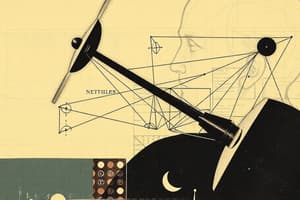Podcast
Questions and Answers
ما هو تأثير زيادة القوة المطبقة على سيارة تتحرك على حلبة جليدية؟
ما هو تأثير زيادة القوة المطبقة على سيارة تتحرك على حلبة جليدية؟
- تجعل السيارة تتحرك بسرعة ثابتة
- تزيد تسارع السيارة (correct)
- تبطئ السيارة
- تزيد احتكاك السيارة بالأرض
ماذا يفعل القانون الأول لنيوتن أثناء المشي عندما نخطو إلى الأمام؟
ماذا يفعل القانون الأول لنيوتن أثناء المشي عندما نخطو إلى الأمام؟
- يحول اتجاه حركتنا إلى الخلف
- يحافظ على توازننا
- يجذبنا للوراء (correct)
- يزيد سرعتنا بشكل مستمر
ما هو تأثير تطبيق قوة أكبر على قدمنا أثناء المشي والتي تفوق قوة الاحتكاك العائدة؟
ما هو تأثير تطبيق قوة أكبر على قدمنا أثناء المشي والتي تفوق قوة الاحتكاك العائدة؟
- الانحراف عن مسار الحركة
- الإبطاء في الحركة
- المحافظة على سرعة مستقرة
- التسارع في الاتجاه المعاكس (correct)
كيف يؤدي القانون الثالث لنيوتن لحركة الجسم إلى الأمام خلال المشي؟
كيف يؤدي القانون الثالث لنيوتن لحركة الجسم إلى الأمام خلال المشي؟
لماذا يظهر تأثير التسارع عند زيادة قوى الجسم المطبقة؟
لماذا يظهر تأثير التسارع عند زيادة قوى الجسم المطبقة؟
Flashcards are hidden until you start studying
Study Notes
Introduction
Newton's laws of motion, also known as Newtonian mechanics, describe the relationship between forces acting upon physical bodies and their resulting accelerations. These laws were first published by Sir Isaac Newton in his book "Philosophiæ Naturalis Principia Mathematica", which was initially released in 1687. Let's dive into the three fundamental principles laid down in this groundbreaking work.

First Law of Motion
The first law of motion, also known as the law of inertia, states that an object will remain at rest or continue moving at constant velocity unless acted upon by an external force. In simpler terms, if you push or pull something, it doesn't move until you stop pushing or pulling. It takes a certain amount of force to start things up and keep them going. This is why friction exists – to oppose relative motion and prevent objects from slipping past each other.
Example: Imagine you are standing still in the middle of a crowded room. As long as you don't bump into anyone or anything, you stay exactly where you are.
Second Law of Motion
The second law of motion relates an object's acceleration to the net force acting on it and its mass. It can be summarized as follows: F = ma, where F represents the force applied, m denotes the mass of the body undergoing movement, and a is the acceleration resulting from that force. This law also shows that forces do work only when they cause the motion of objects and change their state of motion.
Example: If you apply more force to a car moving on an ice rink, it will accelerate faster because your applied force now has to overcome the friction acting against its movement.
Third Law of Motion
The third law of motion states that for every action, there is an equal and opposite reaction. This means that when two bodies exert forces on each other, they experience equal and opposite forces in response. This law is fundamental to our understanding of motion and interactions between objects or bodies.
Example: When you jump into the air, your feet push down on the ground with an equal and opposite force, propelling you back upwards.
Walking Movement and Newton's Laws
Now let's consider the practical example of walking:
- The first law explains that when we take a step forward, pushing off from the ground, our legs must keep moving until they contact the ground again. Otherwise, we would fall backwards!
- The second law comes into play as we apply more force to our foot than the frictional force trying to slow us down. As a result, we accelerate forwards.
- Finally, when we take another step and push ourselves backward (backward reaction force), the third law ensures that our body will move forward in response.
These three laws, though simple, are incredibly powerful tools used by scientists and engineers to understand and predict how objects move. They have revolutionized our understanding of physics and continue to shape modern science today.
Impact of Forces on Movement
Understanding these laws also helps us comprehend how different factors like mass, velocity, and forces affect movement:
- Mass: Objects with larger masses require greater forces before they start or stop moving (F = ma). For example, pushing a shopping cart filled with groceries requires more effort than pushing an empty cart.
- Velocity: The faster an object is moving, the more force is needed to change its motion (F = ma). This is why cars need powerful brakes – they're much harder to stop than bikes!
- Forces: Different types of forces can cause different kinds of movements. For example, gravity pulls objects towards each other, while friction resists movement.
Studying That Suits You
Use AI to generate personalized quizzes and flashcards to suit your learning preferences.




